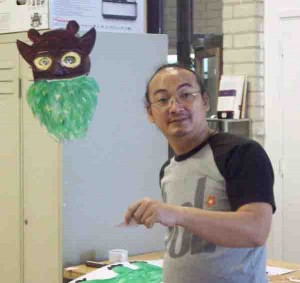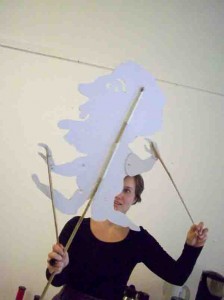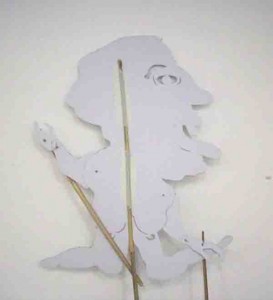Went to the Tropenmuseum today to see more of Heri Dono's work.. The Tropenmuseum invited…
War of Java – do you remember?
 Discussed our series of workshops connected to the ‘Beyond the Dutch’ exhibition at the Centraal Museum Utrecht in an earlier post. Today we did a workshop in the same series with Heri Dono and Jompet, exiting stuff!
Discussed our series of workshops connected to the ‘Beyond the Dutch’ exhibition at the Centraal Museum Utrecht in an earlier post. Today we did a workshop in the same series with Heri Dono and Jompet, exiting stuff!
Some notes:
Heri (picture on the left) uses puppets a lot, because they make his message come through better than with ‘just’ sculpture, He borrows from the traditional wajang theatre and puts on live shows a lot. Quote: “we use our body to connect to the soul of a place.”
Another quote from Heri: “having creative ideas is like having a well. When you keep getting water out and share it with your neighbours, the well stays sweet. When you keep everything to yourself, the water becomes poisoned. ”
Jompet gave us a short history of Java as an introduction to his work ‘War of Java – do you remember? Java used to be Animist, then Bhuddism and Hinduism came in around 600, then the Muslim faith around 1500. Javan people adjusted to the new belief systems and made them their own, mingling the old beliefs with the new. Which is why there are – at this present day – ceremonies for the sea and the mountains done in Arabic, and why the Sultan of Jogjakarta reconstructed his family tree to show that he is a direct descendant from Adam and Eve. This is also why the wajang puppets have changed shape to almost-non-human: to accommodate the Muslim ban against portraying people. Never knew that ….
Anyway, the part of Jompets approach that interested me most is that he sees the introduction of machinery and factories by the Dutch as the introduction of yet another belief system to be accommodated. This is a new thought for me – I used to think of the industrial revolution (and the enlightenment that preceded it) as something other than religion, a new way of thinking and living, outside of religion, having no common ground with it. The picture of Javanese people having a religious ceremony at the installation of their first sugar plant used to be just a funny and maybe sort of primitive thing to me – why mix religion and industry? Jompet gave me a whole new perspective on this. Can industrialisation, modernism and post-modernism be constructed as yet another belief system? To be accommodated by the people of Java like they accommodated so many new belief systems in the past?
Jompet’s ‘War of Java – do you remember’ gives us military uniforms that are in themselves a war: a warring of symbols of Muslim, Hindu, Javan and Buddhist descent, a warring for pride of place on the body of the soldier.
In the film he made of a Javanese dancer in the first sugar cane factory he unites the past (spirits of the ancesters drawn to the dance) with the present (the dancer himself) and the future (the factory). Beautiful to see the supple movements of the dancer contrasted with the mechanic movements of the machines. Time is not linear in Java – at least not during this performance.
In the afternoon, we made masks and wajang puppets with Heri. I was thinking of Jompets’ talk about the wajang puppets having to change shape to almost-not-humans. Reminded me of the way women were portrayed as old-and-ugly-and-evil to make them into wiches, into ‘the other’, and make burning them seem like a good idea. So I made a witch, an old crone with floppy breasts and I-will-come-and-grab-you hands. And here she is:


| « Zipper zone | <-- previous post | next post --> | Experiment 004/2009: A line made by walking » |
|---|







